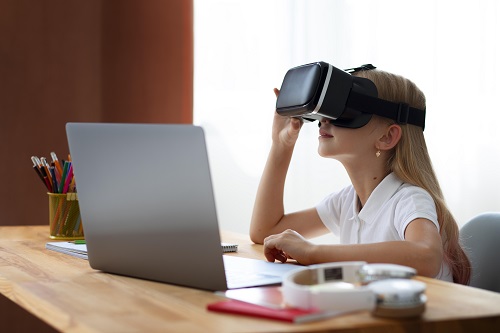How Virtual Reality Will Change Education

Virtual Reality (VR) technology has the potential to revolutionize the way we approach education. By creating immersive and interactive learning environments, VR offers a unique opportunity to enhance the learning experience and make it more engaging, effective, and accessible.
Immersive Learning Experiences
According to VR Today Magazine, which has a dedicated category on VR Applications, one of the most significant advantages of VR in education is its ability to transport students to virtually any location or environment. Virtual field trips can take students to historical sites, museums, or even outer space, providing them with a firsthand experience that would otherwise be impossible or impractical.
Similarly, simulations can recreate complex scenarios, such as scientific experiments, surgical procedures, or natural disasters, allowing students to learn through hands-on practice in a safe and controlled environment.
VR can also enhance traditional learning materials by making them more interactive and engaging.
For example, instead of reading about the human body from a textbook, students can explore a 3D model and interact with different organs and systems. This approach not only makes the learning process more enjoyable but also facilitates better understanding and retention of information.
Personalized and Adaptive Learning
VR technology can be used to create personalized learning experiences that cater to individual learning styles and needs. By tracking student performance and behavior, VR systems can adapt the content, pace, and difficulty level to ensure that each student receives the most effective learning experience.
VR can also be a powerful tool for students with special needs, such as those with physical or cognitive disabilities. By providing a safe and controlled environment, VR can help these students learn and practice skills that may be challenging or dangerous in the real world.
Additionally, VR can be customized to accommodate different abilities and learning preferences, ensuring that no student is left behind.
Enhanced Collaboration and Engagement
VR can facilitate collaboration and communication among students and educators, even when they are physically separated.
Virtual classrooms and collaborative environments can enable real-time interactions, group discussions, and collaborative projects, fostering a sense of community and enhancing the learning experience.
By incorporating elements of gamification, such as rewards, challenges, and leaderboards, VR can make learning more engaging and motivating for students. This approach can help students stay focused, motivated, and invested in their learning, leading to better outcomes and increased retention.
Challenges and Considerations
Implementing VR technology in educational settings can be costly, as it requires specialized hardware, software, and infrastructure while educators and support staff may need training to effectively integrate VR into their teaching practices.
While VR offers a safe and controlled environment for learning, there are potential health and safety concerns that need to be addressed. These include motion sickness, eye strain, and potential physical injuries from interacting with virtual environments.
As with any technology that collects and processes personal data, there are ethical and privacy concerns surrounding the use of VR in education. Ensuring the protection of student data and privacy will be crucial as VR becomes more prevalent in educational settings.
Conclusion
Virtual Reality has the potential to transform the way we approach education, offering immersive and interactive learning experiences, personalized and adaptive learning, enhanced collaboration and engagement, and accessibility for students with special needs.
While there are challenges to overcome, such as cost, infrastructure, and health and safety concerns, the benefits of VR in education are significant.
As technology continues to evolve, it is likely that VR will become an increasingly integral part of the educational landscape, providing students with new and innovative ways to learn and grow.